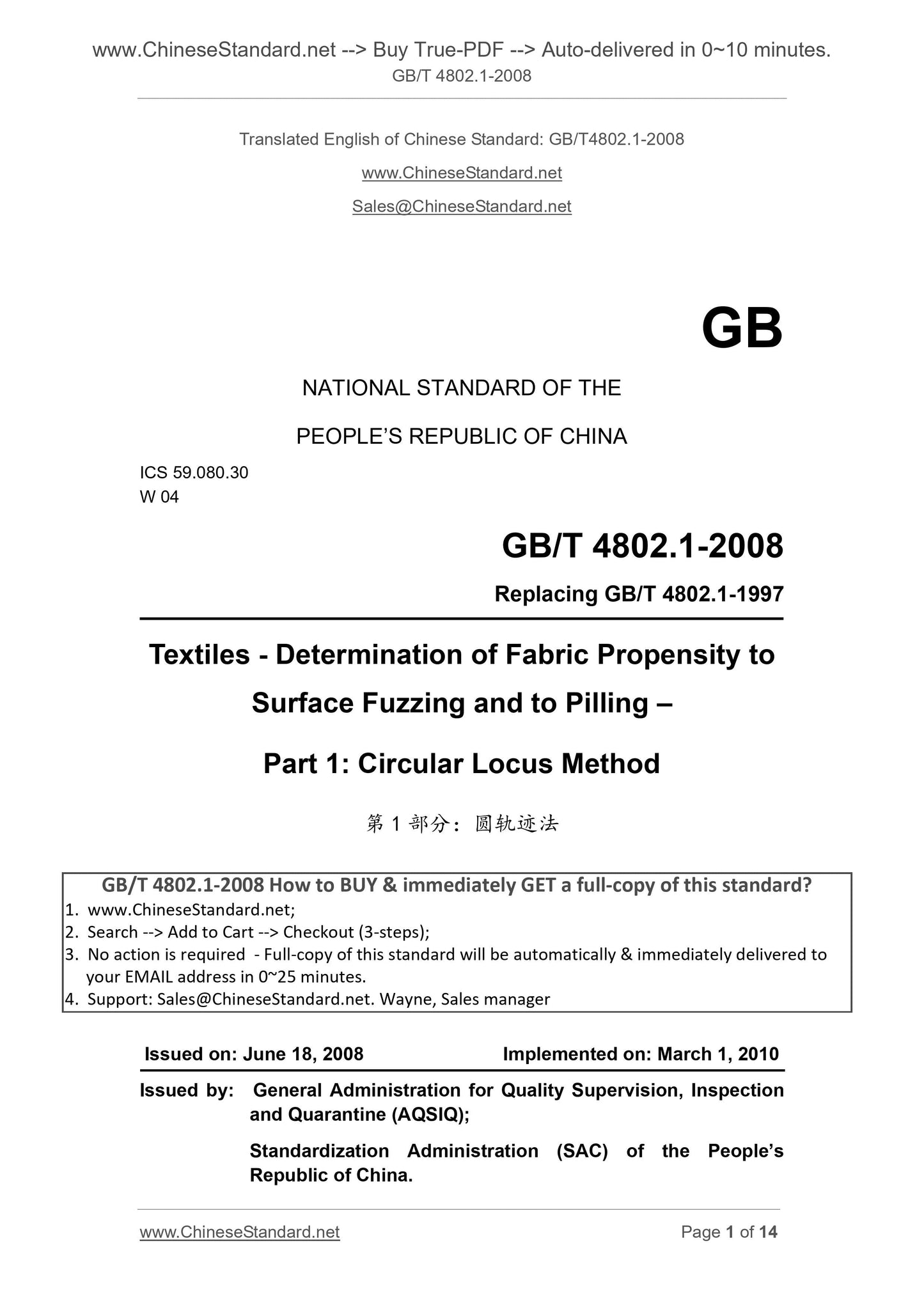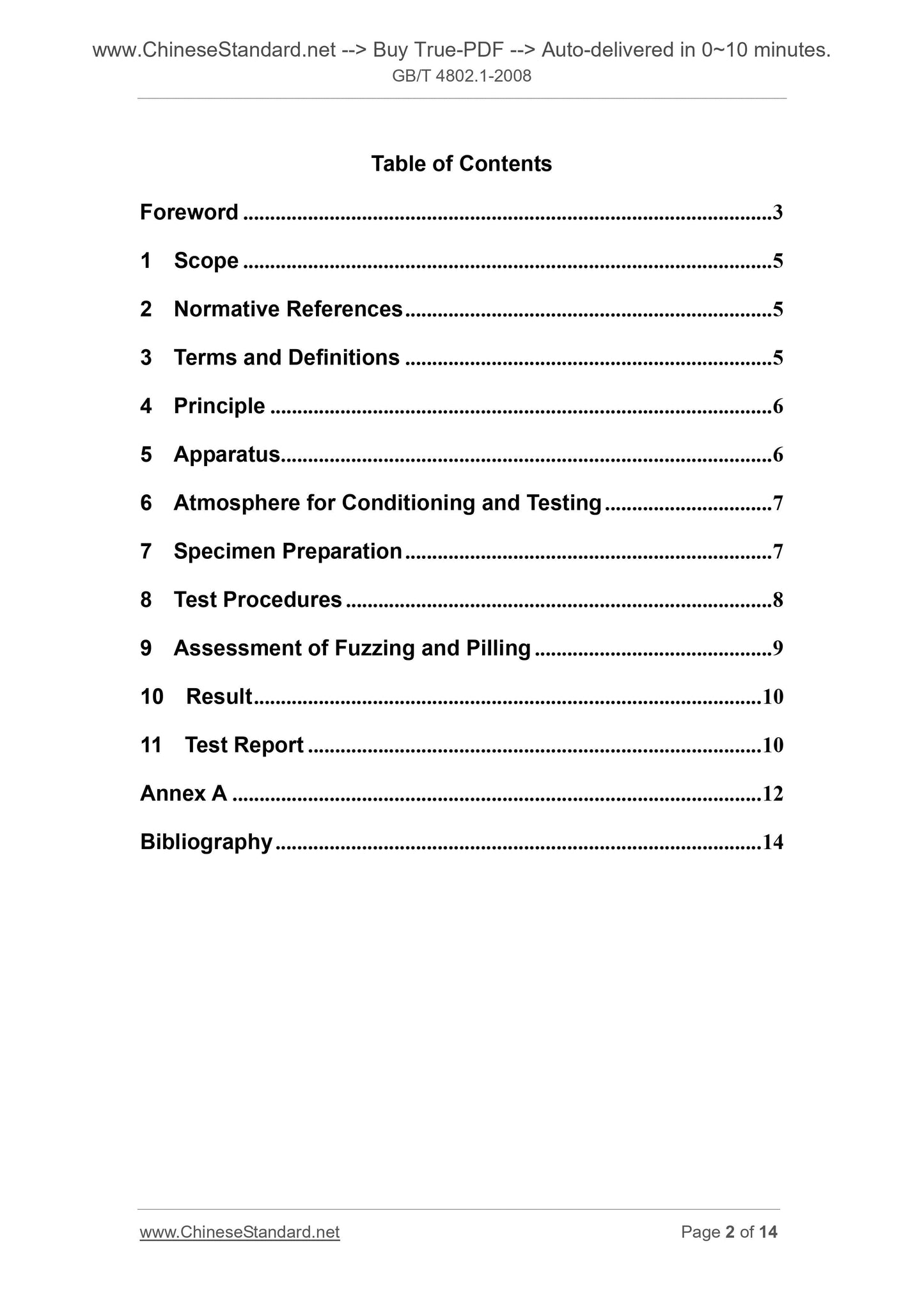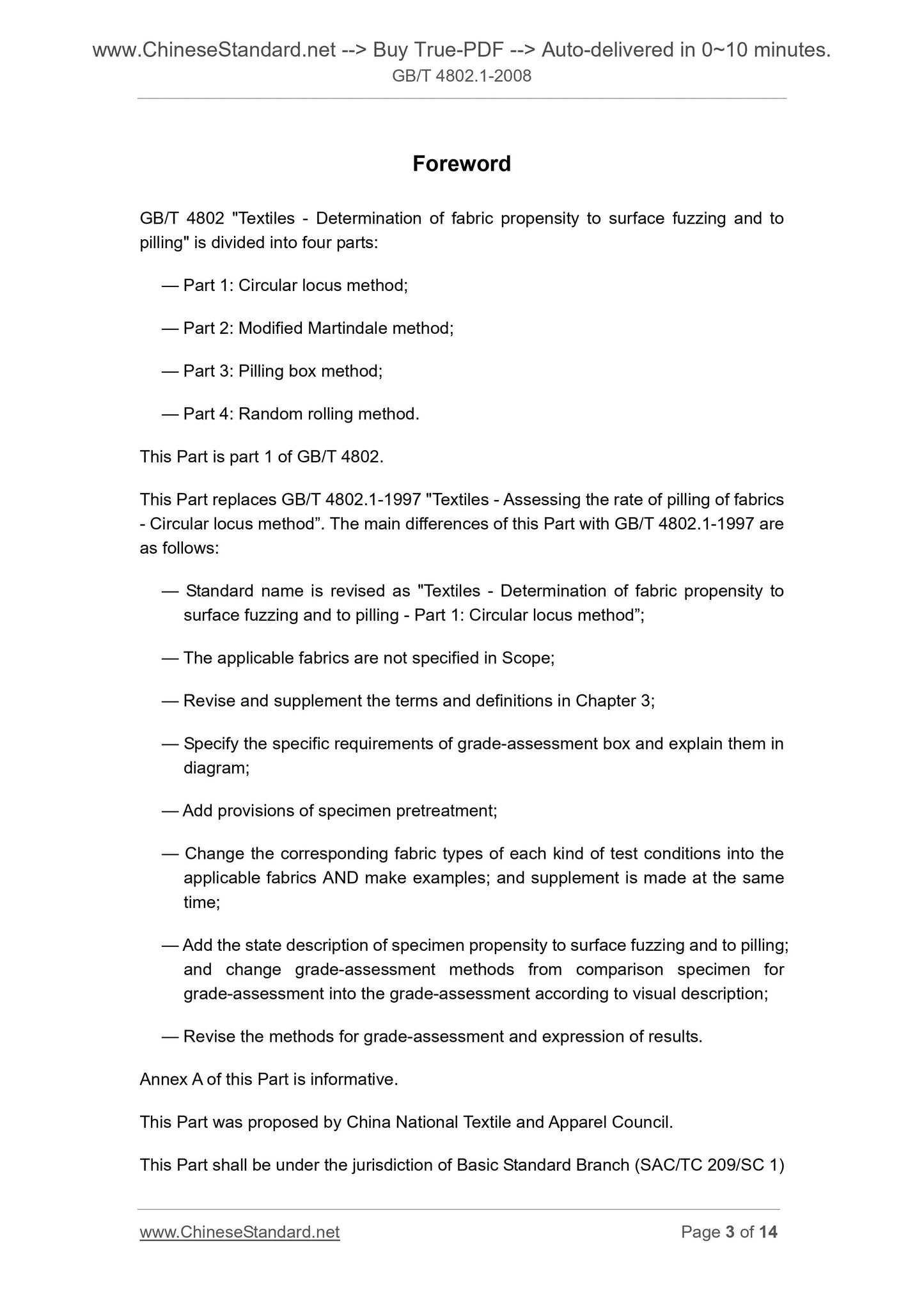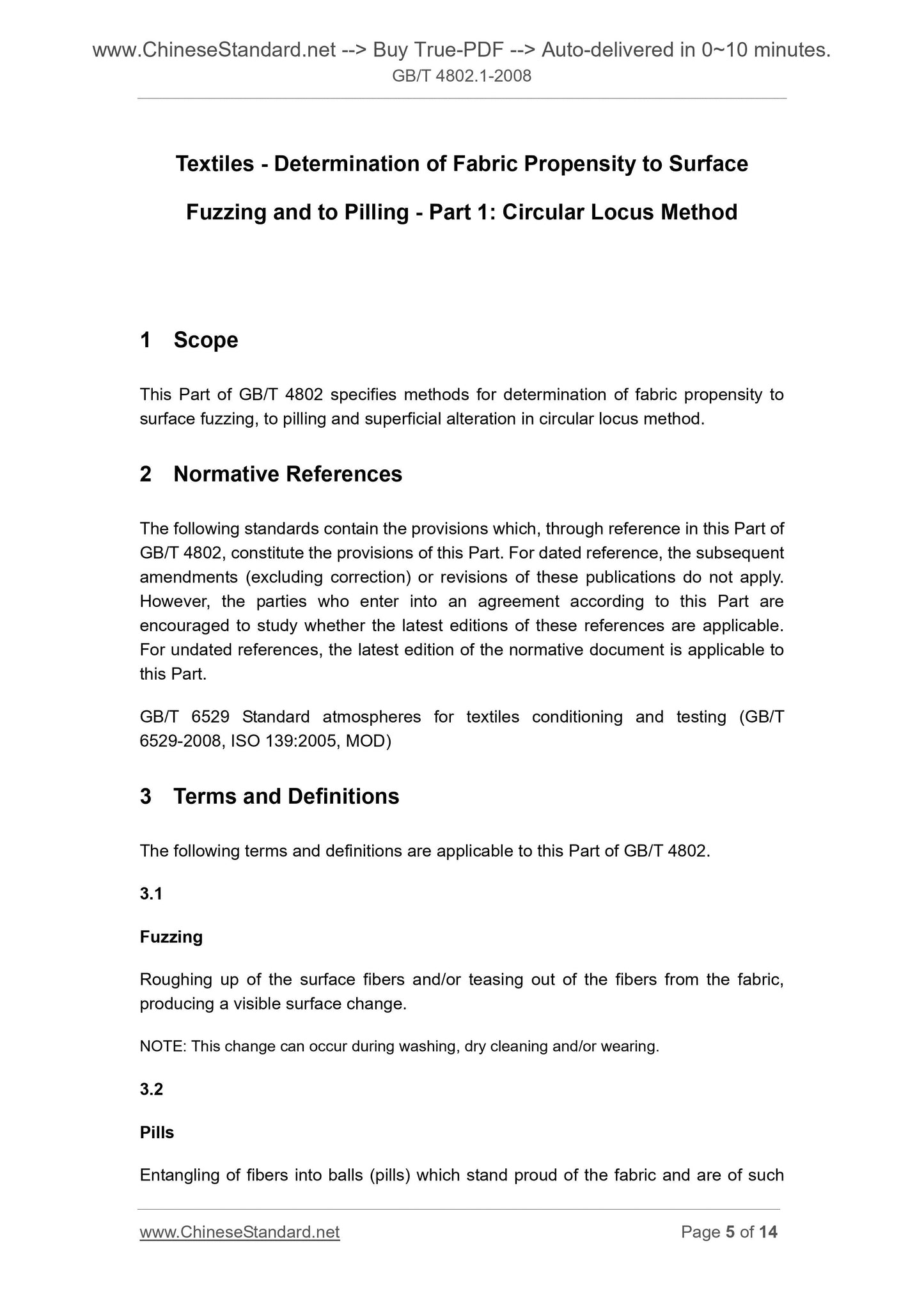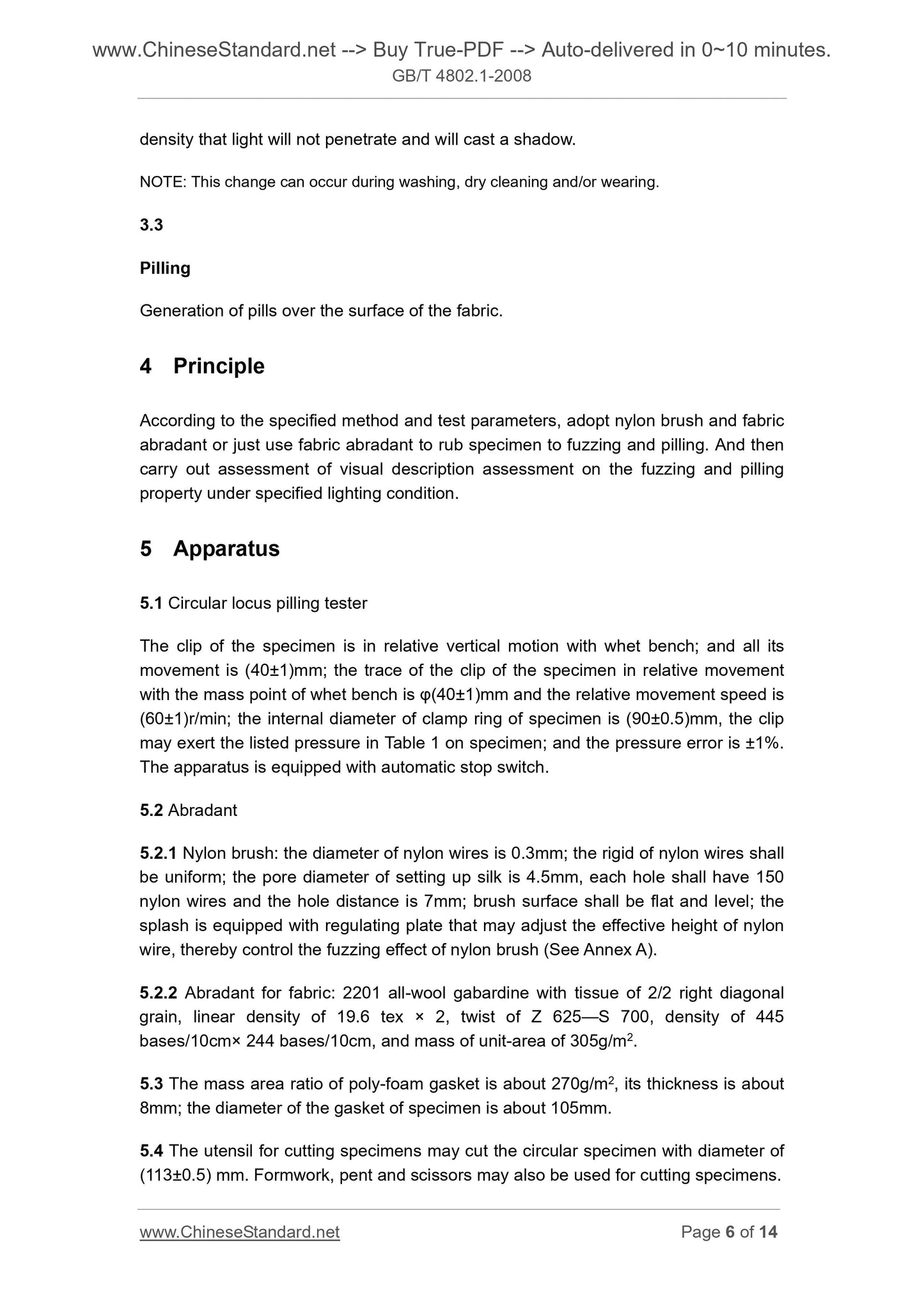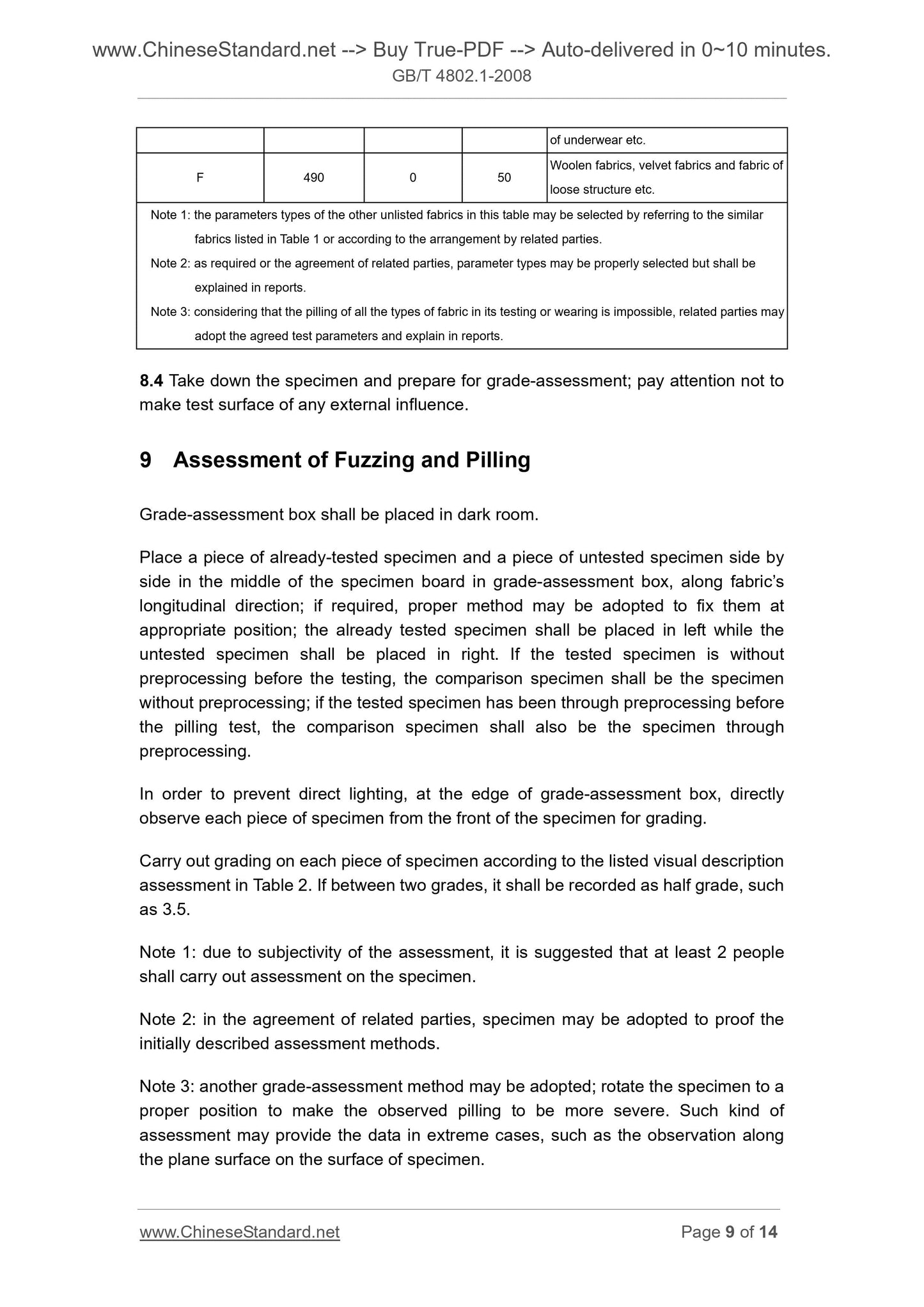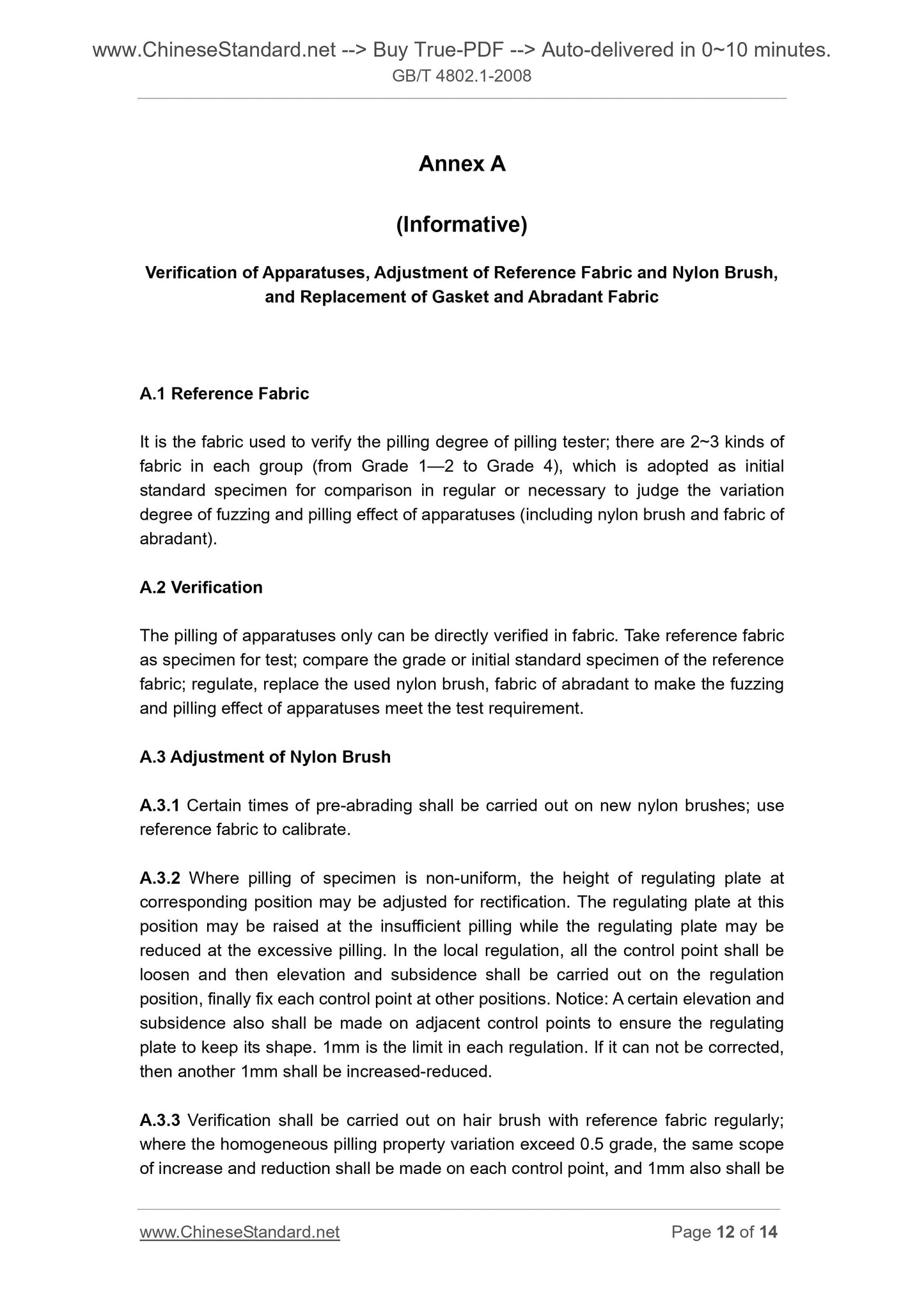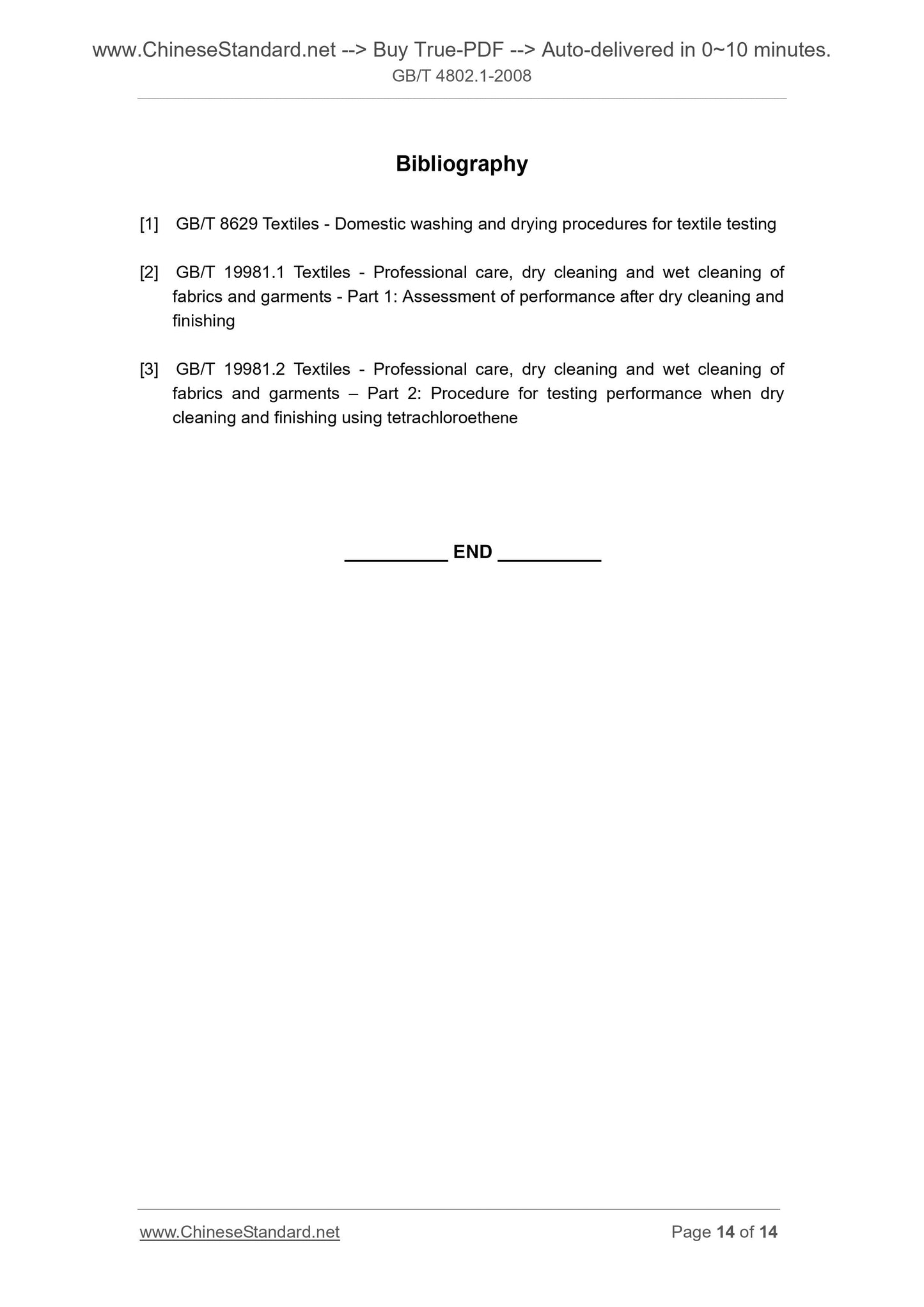1
/
su
8
PayPal, credit cards. Download editable-PDF and invoice in 1 second!
GB/T 4802.1-2008 English PDF (GBT4802.1-2008)
GB/T 4802.1-2008 English PDF (GBT4802.1-2008)
Prezzo di listino
$85.00 USD
Prezzo di listino
Prezzo scontato
$85.00 USD
Prezzo unitario
/
per
Spese di spedizione calcolate al check-out.
Impossibile caricare la disponibilità di ritiro
Delivery: 3 seconds. Download true-PDF + Invoice.
Get QUOTATION in 1-minute: Click GB/T 4802.1-2008
Historical versions: GB/T 4802.1-2008
Preview True-PDF (Reload/Scroll if blank)
GB/T 4802.1-2008: Textiles -- Determination of fabric propensity for fuzzing and pilling -- Part 1: Circular locus method
GB/T 4802.1-2008
GB
NATIONAL STANDARD OF THE
PEOPLE’S REPUBLIC OF CHINA
ICS 59.080.30
W 04
Replacing GB/T 4802.1-1997
Textiles - Determination of Fabric Propensity to
Surface Fuzzing and to Pilling –
Part 1. Circular Locus Method
ISSUED ON. JUNE 18, 2008
IMPLEMENTED ON. MARCH 1, 2010
Issued by. General Administration for Quality Supervision, Inspection
and Quarantine (AQSIQ);
Standardization Administration (SAC) of the People’s
Republic of China.
Table of Contents
Foreword ... 3
1 Scope ... 5
2 Normative References ... 5
3 Terms and Definitions ... 5
4 Principle ... 6
5 Apparatus... 6
6 Atmosphere for Conditioning and Testing ... 7
7 Specimen Preparation ... 7
8 Test Procedures ... 8
9 Assessment of Fuzzing and Pilling ... 9
10 Result ... 10
11 Test Report ... 10
Annex A ... 12
Bibliography ... 14
Foreword
GB/T 4802 "Textiles - Determination of fabric propensity to surface fuzzing and to
pilling" is divided into four parts.
— Part 1. Circular locus method;
— Part 2. Modified Martindale method;
— Part 3. Pilling box method;
— Part 4. Random rolling method.
This Part is part 1 of GB/T 4802.
This Part replaces GB/T 4802.1-1997 "Textiles - Assessing the rate of pilling of fabrics
- Circular locus method”. The main differences of this Part with GB/T 4802.1-1997 are
as follows.
— Standard name is revised as "Textiles - Determination of fabric propensity to
surface fuzzing and to pilling - Part 1. Circular locus method”;
— The applicable fabrics are not specified in Scope;
— Revise and supplement the terms and definitions in Chapter 3;
— Specify the specific requirements of grade-assessment box and explain them in
diagram;
— Add provisions of specimen pretreatment;
— Change the corresponding fabric types of each kind of test conditions into the
applicable fabrics AND make examples; and supplement is made at the same
time;
— Add the state description of specimen propensity to surface fuzzing and to pilling;
and change grade-assessment methods from comparison specimen for
grade-assessment into the grade-assessment according to visual description;
— Revise the methods for grade-assessment and expression of results.
Annex A of this Part is informative.
This Part was proposed by China National Textile and Apparel Council.
This Part shall be under the jurisdiction of Basic Standard Branch (SAC/TC 209/SC 1)
Textiles - Determination of Fabric Propensity to Surface
Fuzzing and to Pilling - Part 1. Circular Locus Method
1 Scope
This Part of GB/T 4802 specifies methods for determination of fabric propensity to
surface fuzzing, to pilling and superficial alteration in circular locus method.
2 Normative References
The following standards contain the provisions which, through reference in this Part of
GB/T 4802, constitute the provisions of this Part. For dated reference, the subsequent
amendments (excluding correction) or revisions of these publications do not apply.
However, the parties who enter into an agreement according to this Part are
encouraged to study whether the latest editions of these references are applicable.
For undated references, the latest edition of the normative document is applicable to
this Part.
GB/T 6529 Standard atmospheres for textiles conditioning and testing (GB/T
6529-2008, ISO 139.2005, MOD)
3 Terms and Definitions
The following terms and definitions are applicable to this Part of GB/T 4802.
3.1
Fuzzing
Roughing up of the surface fibers and/or teasing out of the fibers from the fabric,
producing a visible surface change.
NOTE. This change can occur during washing, dry cleaning and/or wearing.
3.2
Pills
Entangling of fibers into balls (pills) which stand proud of the fabric and are of such
density that light will not penetrate and will cast a shadow.
NOTE. This change can occur during washing, dry cleaning and/or wearing.
3.3
Pilling
Generation of pills over the surface of the fabric.
4 Principle
According to the specified method and test parameters, adopt nylon brush and fabric
abradant or just use fabric abradant to rub specimen to fuzzing and pilling. And then
carry out assessment of visual description assessment on the fuzzing and pilling
property under specified lighting condition.
5 Apparatus
5.1 Circular locus pilling tester
The clip of the specimen is in relative vertical motion with whet bench; and all its
movement is (40±1)mm; the trace of the clip of the specimen in relative movement
with the mass point of whet bench is φ(40±1)mm and the relative movement speed is
(60±1)r/min; the internal diameter of clamp ring of specimen is (90±0.5)mm, the clip
may exert the listed pressure in Table 1 on specimen; and the pressure error is ±1%.
The apparatus is equipped with automatic stop switch.
5.2 Abradant
5.2.1 Nylon brush. the diameter of nylon wires is 0.3mm; the rigid of nylon wires shall
be uniform; the pore diameter of setting up silk is 4.5mm, each hole shall have 150
nylon wires and the hole distance is 7mm; brush surface shall be flat and level; the
splash is equipped with regulating plate that may adjust the effective height of nylon
wire, thereby control the fuzzing effect of nylon brush (See Annex A).
5.2.2 Abradant for fabric. 2201 all-wool gabardine with tissue of 2/2 right diagonal
grain, linear density of 19.6 tex × 2, twist of Z 625—S 700, density of 445
bases/10cm× 244 bases/10cm, and mass of unit-area of 305g/m2.
5.3 The mass area ratio of poly-foam gasket is about 270g/m2, its thickness is about
8mm; the diameter of the gasket of specimen is about 105mm.
5.4 The utensil for cutting specimens may cut the circular specimen with diameter of
(113±0.5) mm. Formwork, pent and scissors may also be used for cutting specimens.
of underwear etc.
F 490 0 50 Woolen fabrics, velvet fabrics and fabric of loose structure etc.
Note 1. the parameters types of the other unlisted fabrics in this table may be selected by referring to the similar
fabrics listed in Table 1 or according to the arrangement by related parties.
Note 2. as required or the agreement of related parties, parameter types may be properly selected but shall be
explained in reports.
Note 3. considering that the pilling of all the types of fabric in its testing or wearing is impossible, related parties may
adopt the agreed test parameters and explain in reports.
8.4 Take down the specimen and prepare for grade-assessment; pay attention not to
make test surface of any external influence.
9 Assessment of Fuzzing and Pilling
Grade-assessment box shall be placed in dark room.
Place a piece of already-tested specimen and a piece of untested specimen side by
side in the middle of the specimen board in grade-assessment box, along fabric’s
longitudinal direction; if required, proper method may be adopted to fix them at
appropriate position; the already tested specimen shall be placed in left while the
untested specimen shall be placed in right. If the tested specimen is without
preprocessing before the testing, the comparison specimen shall be the specimen
without preprocessing; if the tested specimen has been through preprocessing before
the pilling test, the comparison specimen shall also be the specimen through
preprocessing.
In order to prevent direct lighting, at the edge of grade-assessment box, directly
observe each piece of specimen from the front of the specimen for grading.
Ca...
Get QUOTATION in 1-minute: Click GB/T 4802.1-2008
Historical versions: GB/T 4802.1-2008
Preview True-PDF (Reload/Scroll if blank)
GB/T 4802.1-2008: Textiles -- Determination of fabric propensity for fuzzing and pilling -- Part 1: Circular locus method
GB/T 4802.1-2008
GB
NATIONAL STANDARD OF THE
PEOPLE’S REPUBLIC OF CHINA
ICS 59.080.30
W 04
Replacing GB/T 4802.1-1997
Textiles - Determination of Fabric Propensity to
Surface Fuzzing and to Pilling –
Part 1. Circular Locus Method
ISSUED ON. JUNE 18, 2008
IMPLEMENTED ON. MARCH 1, 2010
Issued by. General Administration for Quality Supervision, Inspection
and Quarantine (AQSIQ);
Standardization Administration (SAC) of the People’s
Republic of China.
Table of Contents
Foreword ... 3
1 Scope ... 5
2 Normative References ... 5
3 Terms and Definitions ... 5
4 Principle ... 6
5 Apparatus... 6
6 Atmosphere for Conditioning and Testing ... 7
7 Specimen Preparation ... 7
8 Test Procedures ... 8
9 Assessment of Fuzzing and Pilling ... 9
10 Result ... 10
11 Test Report ... 10
Annex A ... 12
Bibliography ... 14
Foreword
GB/T 4802 "Textiles - Determination of fabric propensity to surface fuzzing and to
pilling" is divided into four parts.
— Part 1. Circular locus method;
— Part 2. Modified Martindale method;
— Part 3. Pilling box method;
— Part 4. Random rolling method.
This Part is part 1 of GB/T 4802.
This Part replaces GB/T 4802.1-1997 "Textiles - Assessing the rate of pilling of fabrics
- Circular locus method”. The main differences of this Part with GB/T 4802.1-1997 are
as follows.
— Standard name is revised as "Textiles - Determination of fabric propensity to
surface fuzzing and to pilling - Part 1. Circular locus method”;
— The applicable fabrics are not specified in Scope;
— Revise and supplement the terms and definitions in Chapter 3;
— Specify the specific requirements of grade-assessment box and explain them in
diagram;
— Add provisions of specimen pretreatment;
— Change the corresponding fabric types of each kind of test conditions into the
applicable fabrics AND make examples; and supplement is made at the same
time;
— Add the state description of specimen propensity to surface fuzzing and to pilling;
and change grade-assessment methods from comparison specimen for
grade-assessment into the grade-assessment according to visual description;
— Revise the methods for grade-assessment and expression of results.
Annex A of this Part is informative.
This Part was proposed by China National Textile and Apparel Council.
This Part shall be under the jurisdiction of Basic Standard Branch (SAC/TC 209/SC 1)
Textiles - Determination of Fabric Propensity to Surface
Fuzzing and to Pilling - Part 1. Circular Locus Method
1 Scope
This Part of GB/T 4802 specifies methods for determination of fabric propensity to
surface fuzzing, to pilling and superficial alteration in circular locus method.
2 Normative References
The following standards contain the provisions which, through reference in this Part of
GB/T 4802, constitute the provisions of this Part. For dated reference, the subsequent
amendments (excluding correction) or revisions of these publications do not apply.
However, the parties who enter into an agreement according to this Part are
encouraged to study whether the latest editions of these references are applicable.
For undated references, the latest edition of the normative document is applicable to
this Part.
GB/T 6529 Standard atmospheres for textiles conditioning and testing (GB/T
6529-2008, ISO 139.2005, MOD)
3 Terms and Definitions
The following terms and definitions are applicable to this Part of GB/T 4802.
3.1
Fuzzing
Roughing up of the surface fibers and/or teasing out of the fibers from the fabric,
producing a visible surface change.
NOTE. This change can occur during washing, dry cleaning and/or wearing.
3.2
Pills
Entangling of fibers into balls (pills) which stand proud of the fabric and are of such
density that light will not penetrate and will cast a shadow.
NOTE. This change can occur during washing, dry cleaning and/or wearing.
3.3
Pilling
Generation of pills over the surface of the fabric.
4 Principle
According to the specified method and test parameters, adopt nylon brush and fabric
abradant or just use fabric abradant to rub specimen to fuzzing and pilling. And then
carry out assessment of visual description assessment on the fuzzing and pilling
property under specified lighting condition.
5 Apparatus
5.1 Circular locus pilling tester
The clip of the specimen is in relative vertical motion with whet bench; and all its
movement is (40±1)mm; the trace of the clip of the specimen in relative movement
with the mass point of whet bench is φ(40±1)mm and the relative movement speed is
(60±1)r/min; the internal diameter of clamp ring of specimen is (90±0.5)mm, the clip
may exert the listed pressure in Table 1 on specimen; and the pressure error is ±1%.
The apparatus is equipped with automatic stop switch.
5.2 Abradant
5.2.1 Nylon brush. the diameter of nylon wires is 0.3mm; the rigid of nylon wires shall
be uniform; the pore diameter of setting up silk is 4.5mm, each hole shall have 150
nylon wires and the hole distance is 7mm; brush surface shall be flat and level; the
splash is equipped with regulating plate that may adjust the effective height of nylon
wire, thereby control the fuzzing effect of nylon brush (See Annex A).
5.2.2 Abradant for fabric. 2201 all-wool gabardine with tissue of 2/2 right diagonal
grain, linear density of 19.6 tex × 2, twist of Z 625—S 700, density of 445
bases/10cm× 244 bases/10cm, and mass of unit-area of 305g/m2.
5.3 The mass area ratio of poly-foam gasket is about 270g/m2, its thickness is about
8mm; the diameter of the gasket of specimen is about 105mm.
5.4 The utensil for cutting specimens may cut the circular specimen with diameter of
(113±0.5) mm. Formwork, pent and scissors may also be used for cutting specimens.
of underwear etc.
F 490 0 50 Woolen fabrics, velvet fabrics and fabric of loose structure etc.
Note 1. the parameters types of the other unlisted fabrics in this table may be selected by referring to the similar
fabrics listed in Table 1 or according to the arrangement by related parties.
Note 2. as required or the agreement of related parties, parameter types may be properly selected but shall be
explained in reports.
Note 3. considering that the pilling of all the types of fabric in its testing or wearing is impossible, related parties may
adopt the agreed test parameters and explain in reports.
8.4 Take down the specimen and prepare for grade-assessment; pay attention not to
make test surface of any external influence.
9 Assessment of Fuzzing and Pilling
Grade-assessment box shall be placed in dark room.
Place a piece of already-tested specimen and a piece of untested specimen side by
side in the middle of the specimen board in grade-assessment box, along fabric’s
longitudinal direction; if required, proper method may be adopted to fix them at
appropriate position; the already tested specimen shall be placed in left while the
untested specimen shall be placed in right. If the tested specimen is without
preprocessing before the testing, the comparison specimen shall be the specimen
without preprocessing; if the tested specimen has been through preprocessing before
the pilling test, the comparison specimen shall also be the specimen through
preprocessing.
In order to prevent direct lighting, at the edge of grade-assessment box, directly
observe each piece of specimen from the front of the specimen for grading.
Ca...
Share
